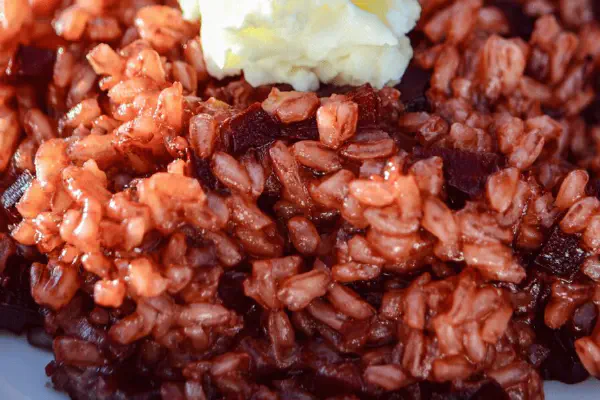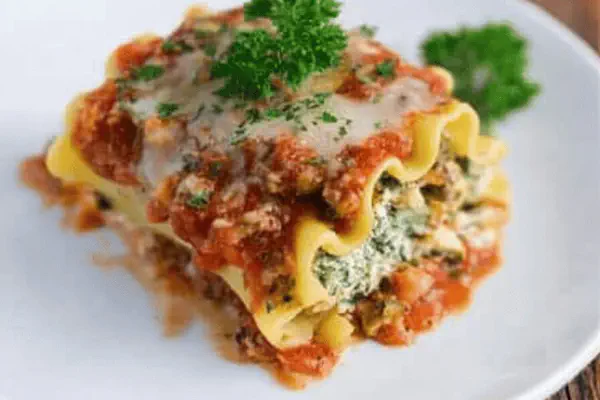Beet Risotto Twist

By Emma
Certified Culinary Professional
Ingredients
- 4 medium beets scrubbed
- 2 tbsp unsalted butter divided
- 2 tbsp olive oil
- 2 shallots finely chopped
- 3 cloves garlic minced
- 1 1/4 cup arborio rice
- 1 1/2 cup dry white wine (sub dry vermouth)
- 5-6 cups vegetable broth kept warm
- 1 tsp kosher salt adjust to taste
- 150g ricotta for serving
- 1 tbsp honey
- Freshly ground black pepper (optional)
About the ingredients
Method
- Beets washed thoroughly then put in deep saucepan with steamer basket, about 2 inches water underneath. Covered and simmered 25-35 minutes, fork-tender when pressed firmly. Let cool enough to handle, then rub skins off with fingers or paper towel. Cut into roughly 1-inch cubes.
- In large heavy-bottomed pan, melt 1 tablespoon butter with olive oil over medium-low heat. Add shallots, garlic. Sweat gently until translucent and soft - no browning, about 4 minutes. Smell should be sweet, mellow. If starts to color, lower heat.
- Pour in arborio rice. Stir constantly to toast grains evenly, until edges get slightly translucent and smell nutty - 2-3 minutes. Toss in half of the beet cubes now. The heat will help release some color into rice. Keeps that earthy feel upfront.
- Meanwhile, warm vegetable broth to near simmer in separate pot, keep covered and on low heat to not cool down when ladling. Best to use homemade or good quality store broth to avoid flatness.
- Add white wine or vermouth in skillet. Stir constantly, hear liquid bubble and vanish, leaving rice grain surfaces tacky but not soupy. That quick evaporation locks in acidity, building risotto balance.
- Start ladling one cup broth at a time into rice mixture allowing each ladle to fully absorb before next addition. Stir often but gently, scraping bottom to prevent sticking or scorching. This slow absorption coax starch release, develops creamy texture without being gluey. About 18-22 minutes total, but trust texture not clock. Rice should be al dente with ‘bite’ still alive. If too mushy, next batches less broth or quicker absorption.
- Near end, salt well and fold in remaining beet cubes to warm through, no more cooking or color loss. This layering keeps vibrant beet flavor starring last.
- Remove from heat. Stir in remaining butter chunk to enrich, bringing glossy finish. Taste and adjust salt, pepper if using.
- Dish into bowls, add generous dollop ricotta on top. Drizzle honey lightly over ricotta and around edges. The sweet contrasts beet earthiness, ricotta cooling creaminess cuts acid.
- Serve immediately. If resting, cover loosely. Prepared this way, risotto nails balance between rustic beets, creamy rice, and fresh aromatics. Experiment with swapping ricotta for mascarpone or goat cheese for tang. For broth, mushroom stock adds depth. Watch heat closely to prevent burning garlic or overcooking rice.
Cooking tips
Chef's notes
- 💡 Steam beets till fork tender, 25-35 mins. Watch water level under basket, keep low but not dry. Warm beets peel faster, fingers or paper towel rub skins away easy. Avoid boiling, losses flavor and color. Roasting shortcut works, but steaming keeps moisture intact and earthiness strong.
- 💡 Butter and olive oil combo for sautéing aromatics. Low temp sweat shallots and garlic slowly. No color allowed. Smell changes to mellow sweetness, that’s clue. If browning, dial back heat quick. Garlic chars fast, bit bitter, ruins base flavor.
- 💡 Toast arborio rice dry in pan till edges become translucent, smell nutty, about 2-3 mins. Stir constantly. This adds texture, keeps grains distinct. Pour wine in before broth. Wine must bubble off entirely to trap acidity. Wine evaporation is subtle but key, taste after for sharp but balanced bite.
- 💡 Broth must be warm, not cold. Cold broth shocks starch breakout, ruins texture. Keep covered pot simmering, ladle slowly one cup at a time. Stir gently between ladles, scrape bottom to stop sticking. Watch rice texture not clock. If mushy, next time less broth or faster cooking.
- 💡 Late beet cubes maintain brightness, fresh bites. Add salt near end, fold beets gently to warm through, avoid extra cooking or bleeding color. Finish with cold butter chunk to bring gloss, richness. Ricotta dollop on top cuts acidity, honey drizzle balances earthiness, textures contrast beautifully.
Common questions
Can I roast beets instead of steaming?
Yes, roast foil-wrapped 40 mins at 400°F works. But steams keep moisture high, flavor sharper. Roasting messier, dryer sometimes. Depends how much time and taste you want.
What if garlic browns while sweating?
Lower heat immediately. Garlic bitterness ruins base aromas. If burnt, toss and restart base with fresh garlic if possible. Low temp patience, slow sweat best. Onion swaps okay but reduce quantity.
Broth too salty, how fix?
Dilute with water or unsalted broth. Use homemade if possible. Taste constantly. Salt late not early. Too salty broth ruins balance, easy to overdo when store-bought. Adjust wine and salt accordingly.
Storing leftovers safe?
Cool quickly, fridge in sealed container 2-3 days max. Reheat gently with splash of warm broth, stir frequently to restore creaminess. Freezing not ideal, texture suffers, rice mushy after thaw.



